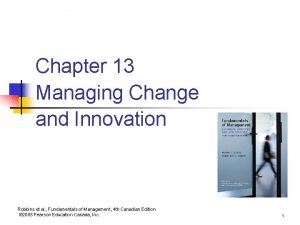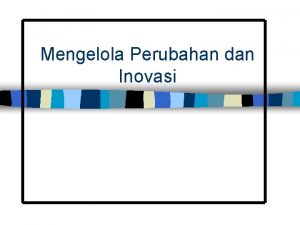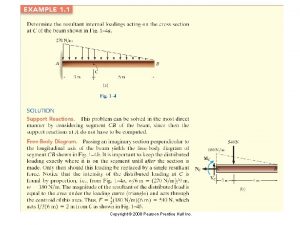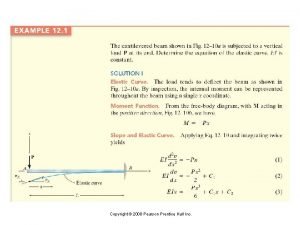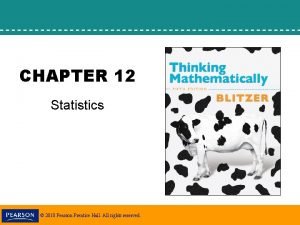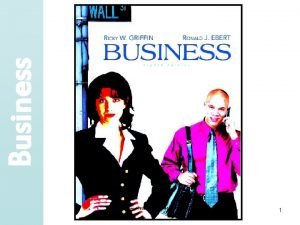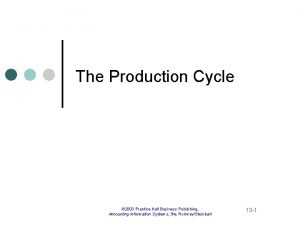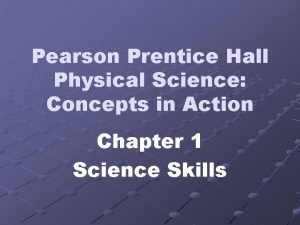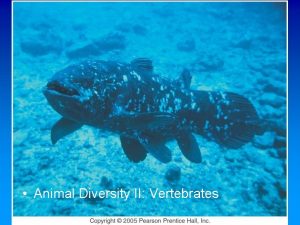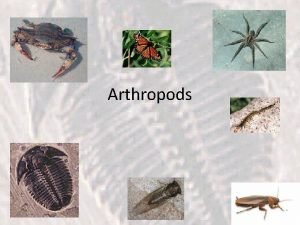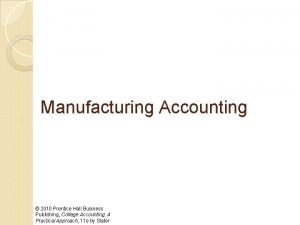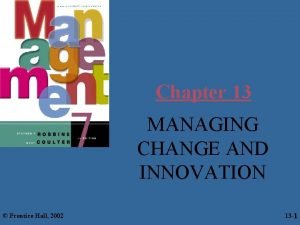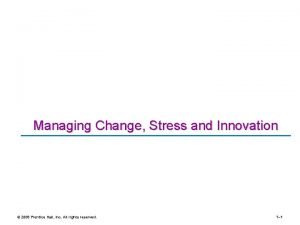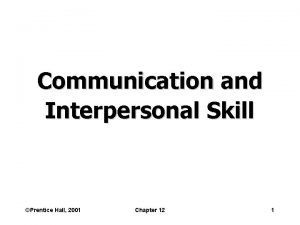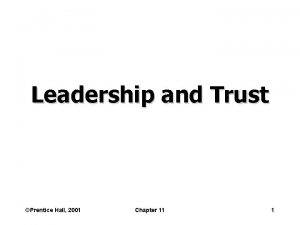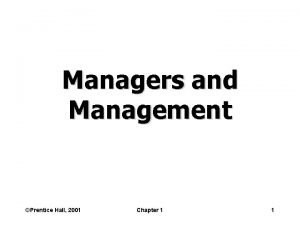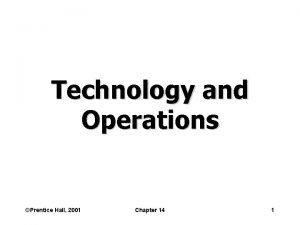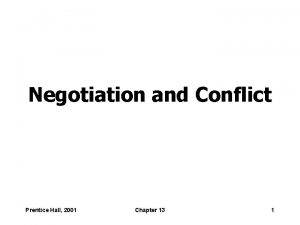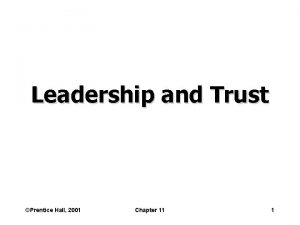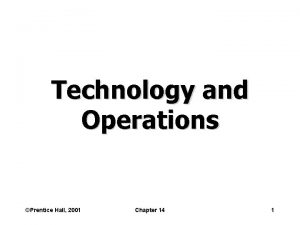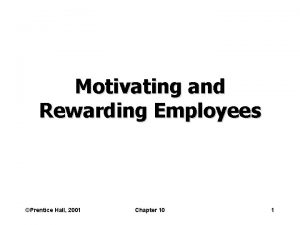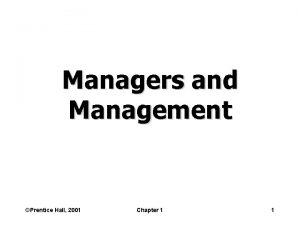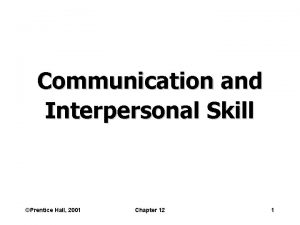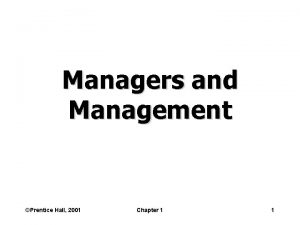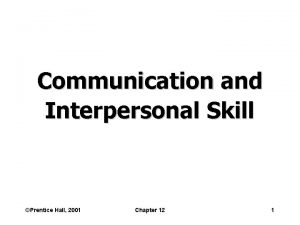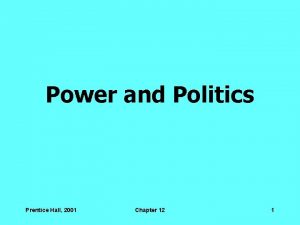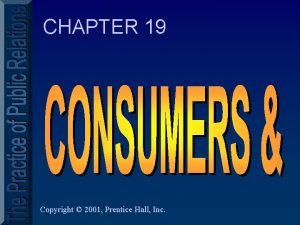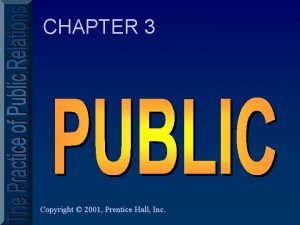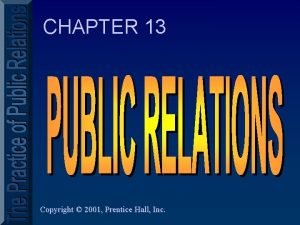Managing Change and Innovation Prentice Hall 2001 Chapter





















- Slides: 21

Managing Change and Innovation ©Prentice Hall, 2001 Chapter 7 1

Learning Outcomes • Describe the change variables a manager can control • Study internal and external forces of change • Analyze managers as change agents • Contrast the “calm waters” and “white water rapids” metaphors for change • Explain why people resist change ©Prentice Hall, 2001 Chapter 7 2

Learning Outcomes • Learn how to reduce resistance to change • Define organization development and learn four OD techniques • Review the causes and symptoms of stress • Compare creativity and innovation • Learn how organizations can stimulate innovation ©Prentice Hall, 2001 Chapter 7 3

Categories of Change People Structure Technology ©Prentice Hall, 2001 Chapter 7 4

External Forces of Change Competition Government Programs Economic Conditions Technology ©Prentice Hall, 2001 Chapter 7 5

Internal Operations Internal Forces of Change ©Prentice Hall, 2001 Impact of External Events Chapter 7 6

Agents of Change Staff Specialists Managers Outside Consultants ©Prentice Hall, 2001 Chapter 7 7

Lewin’s Three-Step Process Unfreezing Changing Refreezing The “Calm Waters” Metaphor ©Prentice Hall, 2001 Chapter 7 8

Lack of Stability Lack of Predictability White-Water Rapids Virtual Chaos ©Prentice Hall, 2001 Constant Change Chapter 7 9

Resistance to Change Uncertainty and Ambiguity Fear of Personal Loss Lack of Faith in Change ©Prentice Hall, 2001 Chapter 7 10

Techniques for Reducing Resistance Education and Communication Participation Negotiation Facilitation and Support Manipulation and Cooptation Coercion ©Prentice Hall, 2001 Chapter 7 11

Techniques for Managing Change Structure Technology People Authority Processes Attitudes Coordination Methods Expectations Centralization Equipment ©Prentice Hall, 2001 Chapter 7 Behavior 12

Organizational Development Techniques • Intergroup development • Process consultation • Survey feedback • Team building ©Prentice Hall, 2001 Chapter 7 13

Constraints Demands What Is Stress? Uncertainty ©Prentice Hall, 2001 Importance Chapter 7 14

Task Demands Role Demands Interpersonal Demands Organizational Stress Factors Structural Dimensions Leadership Techniques ©Prentice Hall, 2001 Chapter 7 15

Personal Stress Factors Family ©Prentice Hall, 2001 Personality Economic Chapter 7 16

Stress Physiological Psychological Behavioral Three General Symptoms ©Prentice Hall, 2001 Chapter 7 17

Stress Management • Selection and placement • Job redesign • Participation • Wellness programs • Employee assistance ©Prentice Hall, 2001 Chapter 7 18

What Is Creativity? • Combining new ideas in unique ways or associating ideas in unusual ways What Is Innovation? • Turning creative ideas into useful products, services, or methods of operation ©Prentice Hall, 2001 Chapter 7 19

The Creative Process Perception Incubation Inspiration Innovation ©Prentice Hall, 2001 Chapter 7 20

Structural Variables Sources of Innovation Organizational Culture Human Resources ©Prentice Hall, 2001 Chapter 7 21
 Managing change and innovation
Managing change and innovation White-water rapids metaphor
White-water rapids metaphor Managing change and innovation
Managing change and innovation 2008 pearson prentice hall inc
2008 pearson prentice hall inc Prentice hall inc
Prentice hall inc 2008 pearson prentice hall inc
2008 pearson prentice hall inc 2005 pearson prentice hall inc
2005 pearson prentice hall inc Pearson prentice hall
Pearson prentice hall Prentice hall inc
Prentice hall inc Prentice hall careers
Prentice hall careers Prentice hall america pathways to the present
Prentice hall america pathways to the present Pearson education inc publishing as pearson prentice hall
Pearson education inc publishing as pearson prentice hall Prentice hall publishing
Prentice hall publishing Prentice hall african american history
Prentice hall african american history Prentice hall physical science: concepts in action
Prentice hall physical science: concepts in action Pearson education 2011
Pearson education 2011 Ocean fisheries
Ocean fisheries Pearson prentice hall
Pearson prentice hall 2005 pearson prentice hall inc
2005 pearson prentice hall inc Pearson education inc publishing as pearson prentice hall
Pearson education inc publishing as pearson prentice hall Common name of arthropoda
Common name of arthropoda Prentice hall business publishing
Prentice hall business publishing

